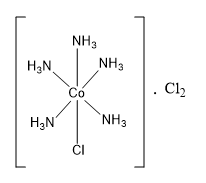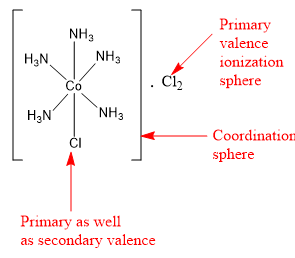
In the compound \[{\text{CoC}}{{\text{l}}_{\text{3}}}{\text{.5N}}{{\text{H}}_{\text{3}}}\] :
(A) all the chlorine shows primary valency only.
(B) Two chlorines show primary valency and one chlorine shows secondary valency.
(C) Two chlorines show primary valency and one chlorine shows primary valency as well as secondary valency.
(D) All then show secondary valency.
Answer
472.8k+ views
Hint: Two spheres, coordination sphere and ionization sphere are present around the central metal atom. Primary valence represents the ionization sphere and the secondary valence represents the coordination sphere.
Complete answer:
The compound \[{\text{CoC}}{{\text{l}}_{\text{3}}}{\text{.5N}}{{\text{H}}_{\text{3}}}\] is a coordination compound. It contains 5 ammonia ligands directly bonded to central cobalt metal. The coordination number of cobalt is 6. So central cobalt metal can have only one other ligand. This another ligand is in the form of one chlorine atom. Thus, the coordination sphere of central cobalt metal contains five ammonia ligands and one chlorine ligand. The remaining two chlorine ligands are present in the ionization sphere.
The ligands present in the coordination sphere are satisfying the secondary valence. Thus, five ammonia molecules and one chlorine ligand are satisfying the secondary valence of cobalt and are present in the coordination sphere. The remaining two chlorine atoms are present in the ionization sphere and satisfy the primary valence (or the oxidation state) of cobalt metal.
The formula of the coordination compound can be written as \[\left[ {{\text{CoCl}}{{\left( {{\text{N}}{{\text{H}}_{\text{3}}}} \right)}_5}} \right] \cdot {\text{C}}{{\text{l}}_{\text{2}}}\] .
Thus, in the compound \[{\text{CoC}}{{\text{l}}_{\text{3}}}{\text{.5N}}{{\text{H}}_{\text{3}}}\], two chlorine show primary valency and one chlorine shows primary valency as well as secondary valency.


Hence, the correct option is the option (C).
Note: There are some examples, in which the same ligand satisfies primary as well as secondary valence. In the coordination compound \[\left[ {{\text{CoCl}}{{\left( {{\text{N}}{{\text{H}}_{\text{3}}}} \right)}_5}} \right] \cdot {\text{C}}{{\text{l}}_{\text{2}}}\] the chlorine ligand present inside the square brackets, satisfies both primary valence and the secondary valence.
Complete answer:
The compound \[{\text{CoC}}{{\text{l}}_{\text{3}}}{\text{.5N}}{{\text{H}}_{\text{3}}}\] is a coordination compound. It contains 5 ammonia ligands directly bonded to central cobalt metal. The coordination number of cobalt is 6. So central cobalt metal can have only one other ligand. This another ligand is in the form of one chlorine atom. Thus, the coordination sphere of central cobalt metal contains five ammonia ligands and one chlorine ligand. The remaining two chlorine ligands are present in the ionization sphere.
The ligands present in the coordination sphere are satisfying the secondary valence. Thus, five ammonia molecules and one chlorine ligand are satisfying the secondary valence of cobalt and are present in the coordination sphere. The remaining two chlorine atoms are present in the ionization sphere and satisfy the primary valence (or the oxidation state) of cobalt metal.
The formula of the coordination compound can be written as \[\left[ {{\text{CoCl}}{{\left( {{\text{N}}{{\text{H}}_{\text{3}}}} \right)}_5}} \right] \cdot {\text{C}}{{\text{l}}_{\text{2}}}\] .
Thus, in the compound \[{\text{CoC}}{{\text{l}}_{\text{3}}}{\text{.5N}}{{\text{H}}_{\text{3}}}\], two chlorine show primary valency and one chlorine shows primary valency as well as secondary valency.


Hence, the correct option is the option (C).
Note: There are some examples, in which the same ligand satisfies primary as well as secondary valence. In the coordination compound \[\left[ {{\text{CoCl}}{{\left( {{\text{N}}{{\text{H}}_{\text{3}}}} \right)}_5}} \right] \cdot {\text{C}}{{\text{l}}_{\text{2}}}\] the chlorine ligand present inside the square brackets, satisfies both primary valence and the secondary valence.
Recently Updated Pages
Master Class 12 Economics: Engaging Questions & Answers for Success

Master Class 12 Maths: Engaging Questions & Answers for Success

Master Class 12 Biology: Engaging Questions & Answers for Success

Master Class 12 Physics: Engaging Questions & Answers for Success

Master Class 12 Business Studies: Engaging Questions & Answers for Success

Master Class 12 English: Engaging Questions & Answers for Success

Trending doubts
Who is Mukesh What is his dream Why does it look like class 12 english CBSE

Who was RajKumar Shukla Why did he come to Lucknow class 12 english CBSE

The word Maasai is derived from the word Maa Maasai class 12 social science CBSE

What is the Full Form of PVC, PET, HDPE, LDPE, PP and PS ?

Which country did Danny Casey play for class 12 english CBSE

Differentiate between insitu conservation and exsitu class 12 biology CBSE




